|

[
Le
Thovey
] - [ Thovey site plan ] - [ Summer 1999
digs campaign
] - [ Tombs found in Lathuille ]
Le
Thovey: a Roman mansio

Under what are
now parts of Faverges and the outlying hamlet
of Viuz, the Roman town of Casuaria marked an important stop
along the Turin-Geneva road, as can be seen in the famous Peutinger
Table (the last surviving Roman road map and travel atlas).
Several Gallo-Roman sites of old Casuaria have been uncovered;
the largest site investigated to date is the dig known as Le
Thovey, within modern Faverges. At Le Thovey, on the outskirts
of ancient Casuaria, archeological digs have been conducted every
summer since 1981. The municipality of Faverges has just acquired
several acres of land from private owners so that the dig may
be extended beyond its current perimeter. Volunteer diggers have
uncovered a mansio, (a type of Roman "motel"),
complete with Roman baths, peristyle, and outbuildings dating
from the 1st-century BC to the 3rd century CE. The mansio and
adjacent buildings were apparently put to the torch by a band
of roving Alaman raiders in the year 270, as has been attested
both by documentary and archeological evidence.
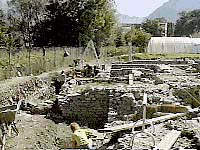 Numerous artifacts from Gallo-Roman times have been
found on the site: after the removal of the topsoil layer, clay
typical of collapsed rammed-earth (pisé)
wall construction was found to cover thousands of roof tiles.
The roof tiles themselves lay over pieces of charcoal which were
certainly the roof beams burnt in the fire of 270 CE. Beneath
the wall and roof rubble, a complete Roman thermal Numerous artifacts from Gallo-Roman times have been
found on the site: after the removal of the topsoil layer, clay
typical of collapsed rammed-earth (pisé)
wall construction was found to cover thousands of roof tiles.
The roof tiles themselves lay over pieces of charcoal which were
certainly the roof beams burnt in the fire of 270 CE. Beneath
the wall and roof rubble, a complete Roman thermal 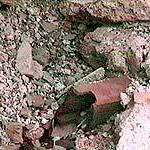 installation was largely in situ: a dressing-room
floored in terrazo, cold, lukewarm and hot bath chambers, the
emplacement of the praefurnium/furnace (photo above), numerous
tile stacks (pilettes) that originally supported
the concrete floor, and hundreds of tubuli, terra-cotta
tubes that installation was largely in situ: a dressing-room
floored in terrazo, cold, lukewarm and hot bath chambers, the
emplacement of the praefurnium/furnace (photo above), numerous
tile stacks (pilettes) that originally supported
the concrete floor, and hundreds of tubuli, terra-cotta
tubes that 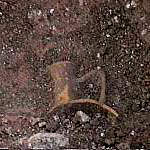 served as smoke
exhausts and heated the walls of the baths (photo at right).
A length of lead pipe was found in its original position, along
with numerous fragments of marble facing around the bath area.
A water pitcher (photo at left) and bone admission tokens were
uncovered near the supposed entrance. served as smoke
exhausts and heated the walls of the baths (photo at right).
A length of lead pipe was found in its original position, along
with numerous fragments of marble facing around the bath area.
A water pitcher (photo at left) and bone admission tokens were
uncovered near the supposed entrance.
In another area
of the dig, across the vestibule that divides the two zones 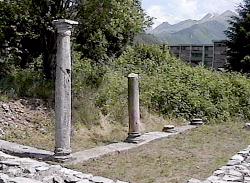 now uncovered,
were found the columns of the peristyle. Now partly re-erected,
(photo at right) it is composed of columns hewn from local stone;
the bases and capitals are not perfectly matched, suggesting
that these were recycled elements. Next to the peristyle was
the kitchen, which was found to contain a large bronze cauldron
in excellent condition. Stew bones were found within the cooking
pot, compelling evidence that the inhabitants left the premises
hastily. The pot is the largest and best-preserved Roman bronze
cauldron ever found. It can now be seen on display in the Archeological Museum
in Viuz
near a legionnaire's hammer, found with part of its wooden handle,
(photo below, at time of discovery) and the largest Roman sawblade
ever found. now uncovered,
were found the columns of the peristyle. Now partly re-erected,
(photo at right) it is composed of columns hewn from local stone;
the bases and capitals are not perfectly matched, suggesting
that these were recycled elements. Next to the peristyle was
the kitchen, which was found to contain a large bronze cauldron
in excellent condition. Stew bones were found within the cooking
pot, compelling evidence that the inhabitants left the premises
hastily. The pot is the largest and best-preserved Roman bronze
cauldron ever found. It can now be seen on display in the Archeological Museum
in Viuz
near a legionnaire's hammer, found with part of its wooden handle,
(photo below, at time of discovery) and the largest Roman sawblade
ever found.

Plan
of the Thovey Site
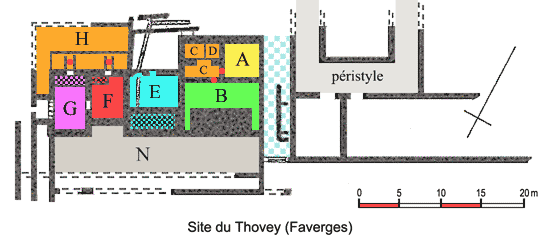
|
A: Entrance
to baths (yellow) |
E: Frigidarium
(blue) |
|
B: Dressing
room (green) |
F: Caldarium
(red) |
|
C: Hypocausts
(orange) |
G: Tepidarium
(pink) |
|
D: Wood
storage (orange) |
H: Annexes
(orange) |
Digs Campaign
- Summer 1999
In August 1999,
the Amis de Viuz-Faverges team began to survey and probe
the zone north of the Thovey digs, on the other side of the mill
run which serves as a border between the digs and the land recently
acquired by the municipality. The photo below, a 360° panorama,
shows the new land and digs on August 5th 1999. A java applet is scripted
into the page, which means that the image should load automatically
and begin to spin slowly. Be patient: though heavily compressed,
it is a large image and takes some time to load.
Once the picture has loaded, it will become visible in the frame
below. You can either let it spin, or click on it to "navigate"
within the scene.
The first tests
show the presence of Roman foundation walls some 1m50 beneath
the surface of a water-logged soil. (Michel Duret is seen probing
the ground, below left) . The mill run or biel, which
on the one hand keeps the diggers' drinks cool, (photo, below
right) threatens to flood the digs through seepage.
 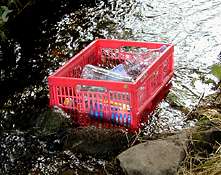
After having
removed manu broken Roman tiles (which bear witness to the collapse
of a roof) the diggers began to find large nails as well as potsherds.
The aim of the digs this summer is to try to map out the ground
plan of the buildings on this land at the time of the destruction
of the villa in the year 270.
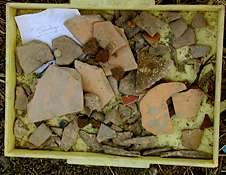 
At left above,
a tray filled with objects found by Alain and Calou (above right)
in the east trench.
July 1999:
Discovery of Merovingian tombs in Lathuille
 While grading the land behind their house
in late July 1999, Mr. and Mrs. Liégeois were surprised
to find human bones where they had planned to place their swimming
pool. Notified by the backhoe operator, the Amis de Viuz-Faverges
went immediately to assess the situation and undertook a rapid
campaign of digging. The archeologists uncovered several tombs,
some oriented along a north/south axis, others in an east-west
direction. The sides of the tombs are made of thin slabs of stone.
By their orientation, their shape, and the absence of artifacts,
these tombs closely resemble Merovingian graves already found
in the general vicinity. While grading the land behind their house
in late July 1999, Mr. and Mrs. Liégeois were surprised
to find human bones where they had planned to place their swimming
pool. Notified by the backhoe operator, the Amis de Viuz-Faverges
went immediately to assess the situation and undertook a rapid
campaign of digging. The archeologists uncovered several tombs,
some oriented along a north/south axis, others in an east-west
direction. The sides of the tombs are made of thin slabs of stone.
By their orientation, their shape, and the absence of artifacts,
these tombs closely resemble Merovingian graves already found
in the general vicinity.
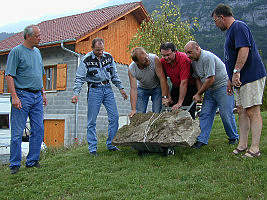 The presence of Roman tiles
attests to the existence of a gallo-roman settlement in the immediate
vicinity. A tomb marker and a fragment of sarcophagus lid were
removed to the Musée Archéologique de Viuz-Faverges.
The bones found in the graves will be studied this winter by
a graduate student currently working on her doctoral thesis at
the University of Geneva. The presence of Roman tiles
attests to the existence of a gallo-roman settlement in the immediate
vicinity. A tomb marker and a fragment of sarcophagus lid were
removed to the Musée Archéologique de Viuz-Faverges.
The bones found in the graves will be studied this winter by
a graduate student currently working on her doctoral thesis at
the University of Geneva.
The diggers wish
to thank the owners of the land as well as the laborers who had
the presence of mind to call in the archeologists, as this discovery
will allow us better to understand the patterns of human settlement
of the county during the High Middle Ages.
 Archeological
Museum Archeological
Museum
IF YOU LIKED THIS WEB PAGE
PLEASE VOTE
BY CLICKING ON THE BUTTON BELOW !

You are cyber-visitor
No.  to the Thovey Digs page! to the Thovey Digs page!
end of current
digs web page
latest update April 20 2000
|





